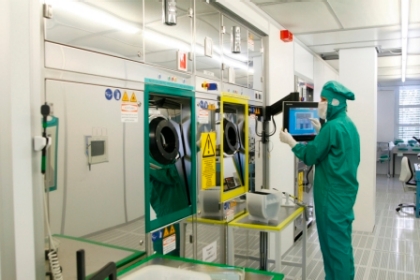June 10, 2011 — Fraunhofer Institute for Microelectronic Circuits and Systems IMS (Duisburg, Germany) developed a new etch process to manufacture micro electromechanical systems (MEMS) for commercial-scale applications. Etching gasses allow MEMS designers to use a wider range of materials for the functional layer, while preventing device damage during etch.
This isotropic etching is based on a substance that etches vertically into the MEMS substrate and tunnels under the functional layer. The result is a functional layer 100nm thin connected to the silicon or other substrate by certain suspension points.
 |
|
A researcher operates Fraunhofer’s MEMS production tools. Copyright Fraunhofer IMS. |
Conventional etch is performed with liquids, and can only remove material vertically, said Dr. Marco Russ, project manager at IMS. When the etch fluid dries, filigree membranes are stuck to the substrate or destroyed. Functional and sacraficial layer materials are limited by the etch liquid.
The group will open a MEMS production facility on June 22, incorporating the etch technology. The new facility will use 2 gases in the etch process chamber instead of liquids, Russ said: Hydrogen fluoride (HF), which strong etching properties on silicon dioxide but does not affect silicon; and xenon difluoride gas (XeF2), which acheives the opposite effect. The gasses allow greater materials flexibility.
Learn more at http://www.fraunhofer.de/en/
Also read: Deep silicon etching used for key MEMS building blocks by Trikon Technologies

